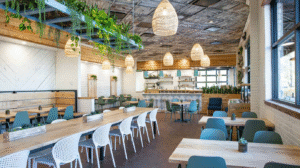Brand Storytelling Through Design: Integrating Graphics, Themes & Identity into Restaurant Interiors

restaurant interior design
In today’s hyper-competitive F&B landscape, serving great food is only part of the equation. For restaurants in Bangalore—a city known for its vibrant culture, diverse palates, and aesthetic sensibilities—interior design is an essential part of the brand narrative.
A restaurant interior design do more than set a mood; they communicate purpose, personality, and promise. At Design Arc Interiors, we believe that interior design is storytelling with space—and for restaurants, that story begins the moment a guest walks through the door.
Why Brand Storytelling Matters in Restaurant Design
Every restaurant has a story. It could be the chef’s culinary journey, a specific cuisine’s history, or a vision rooted in sustainability or nostalgia. Good branding turns this story into a visual and emotional experience—and interior design brings it to life.
Through layout, materials, lighting, typography, color, and thematic décor, a restaurant can:
- Differentiate itself in a crowded market
- Build emotional connections with patrons
- Enhance brand recall and loyalty
- Offer Instagram-worthy experiences that drive organic marketing
Key Elements of Storytelling Through Interior Design
- Visual Identity Through Interior Graphics
Graphics—when thoughtfully integrated—are more than wall art. They are brand markers.
- Logo murals at entrances or behind the counter
- Typography walls featuring quotes, menu items, or slogans in custom fonts
- Illustrations or icons that reflect the cuisine’s origin or style (e.g., spices for Indian, waves for seafood)
These visuals reinforce branding in a way that feels organic, not promotional.
- Thematic Consistency in Decor
If your restaurant’s concept is rooted in tradition, minimalism, or pop culture, the interior must echo it through:
- Props and artifacts (e.g., vintage radios for a retro café)
- Furniture style (industrial metal vs. colonial wood vs. urban chic)
- Color palettes aligned with mood—earth tones for organic eateries, bold reds for energy, soft pastels for calm cafés
Every design choice should serve the larger narrative of what the restaurant is and stands for.
- Local Art & Cultural Motifs
Especially in Bangalore, where cosmopolitan tastes meet rooted tradition, incorporating Kannada typography, local artisan work, or South Indian motifs can bring authenticity. This creates:
- Cultural familiarity for locals
- Experiential depth for tourists
Think: Kolam patterns on floors, mural paintings of old Bangalore, or signage in bilingual scripts.
- Spatial Layout that Tells a Story
Storytelling also extends to how people move through the space:
- A coffee bar at the entrance signals quick service
- An open kitchen builds transparency and trust
- Cozy, dimly lit nooks tell a story of intimacy and romance
- Community tables and open zones tell a story of togetherness and vibrancy
- Lighting as Mood & Message
Lighting is one of the most powerful tools in conveying story:
- Warm pendant lights for rustic, home-style spaces
- Neon signage for urban and edgy eateries
- Soft uplighting for serene fine dining
- Playful lighting sculptures for quirky, youthful cafés
The right lighting scheme not only flatters the food—it immerses guests in your brand’s personality.
Success Stories in Bangalore: Design Arc’s Approach
At Design Arc Interiors, we’ve helped numerous restaurants in Bangalore and beyond turn their stories into spatial experiences. From heritage-themed South Indian restaurants in Jayanagar to modern fusion cafés in Indiranagar, our approach blends:
- Brand identity workshops with the client
- Customized graphic design and signage
- Locally sourced materials and art
- Sustainable, mood-appropriate finishes
Each space is uniquely conceptualized to deliver a cohesive and memorable guest journey.
Conclusion: Design That Serves More Than Aesthetic
In the restaurant world, ambience is the silent ambassador of your brand. By merging storytelling with intelligent interior design, restaurants can elevate themselves from places to dine to experiences that resonate, inspire, and endure.
The next time someone dines at your establishment, let them not just taste your brand—let them feel it, see it, and remember it.








